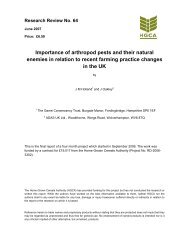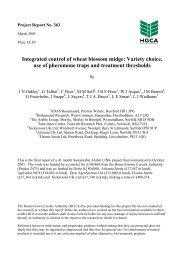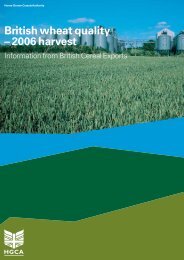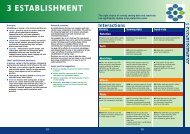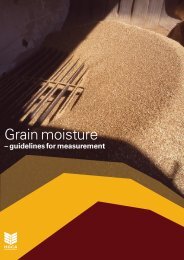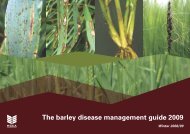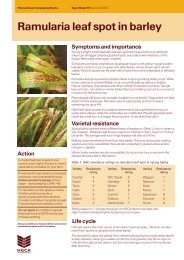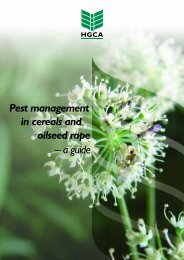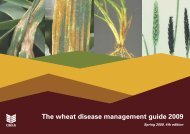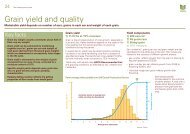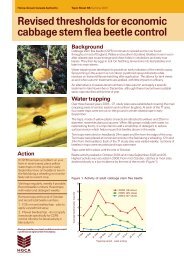BIOETHANOL GREENHOUSE GAS CALCULATOR - HGCA
BIOETHANOL GREENHOUSE GAS CALCULATOR - HGCA
BIOETHANOL GREENHOUSE GAS CALCULATOR - HGCA
You also want an ePaper? Increase the reach of your titles
YUMPU automatically turns print PDFs into web optimized ePapers that Google loves.
30Kyoto Protocol is the Protocol, drafted during the Berlin Mandate process, that, onentry into force, would require countries listed in its Annex B (developed nations) tomeet differentiated reduction targets for their greenhouse gas emissions relative to1990 levels by 2008–12. It was adopted by all Parties to the Climate Convention inKyoto, Japan, in December 1997.Landscape is primarily the visual appearance of the land including its shape, formand colours. However, landscape is not purely a visual phenomenon. The landscaperelies on a range of other dimensions including geology, landform, soils, ecology,archaeology, landscape history, land use, architecture and cultural associations.Land Cover is a combination of land use and vegetation that cover the land surface.Life Cycle is consecutive and interlinked stages of a product system, from rawmaterial acquisition or generation of natural resources to the final disposal (ISO14040).Life-Cycle Analysis is an analysis of the environmental impact of a product duringthe entirety of its lifecycle, from resource extraction to post-consumer waste disposal.It is a comprehensive approach to examining the environmental impacts of a productor package.Life-Cycle Assessment or LCA is a specific method for systematically identifying,quantifying and assessing inputs and outputs (i.e. sources of environmental impact)throughout a product's life cycle. It is one of a range of tools that support life cyclemanagement, but is not a prerequisite for life cycle management (EnvironmentCanada - Environmental Life Cycle Management: A Guide to Better BusinessDecisions). See also ‘Well-to-Wheel’ and ‘Well-to-Tank’ LCA.Life-Cycle Assessment or LCA is a process of evaluating the effects that a producthas on the environment over the entire period of its life thereby increasing resourceuseefficiency and decreasing liabilities. It can be used to study the environmentalimpact of either a product or the function the product is designed to perform. LCA iscommonly referred to as a “cradle-to-grave” analysis. LCA's key elements are: (1)identify and quantify the environmental loads involved; e.g. the energy and rawmaterials consumed, the emissions and wastes generated; (2) evaluate the potentialenvironmental impacts of these loads; and (3) assess the options available forreducing these environmental impacts.Life cycle assessment (LCA) is:the overall process of assessing the life cycle impacts associated with a system,function, product or service. Sometimes considered to include the Initiation,Inventory, Impact Analysis and Improvement stages (SPOLD 93):• A concept and a method to evaluate the environmental effects of a productholistically, by analysing its entire life cycle. This includes identifying andquantifying a-energy and materials used and wastes released to theenvironment, assessing their environmental impact, and evaluatingopportunities for improvement (CAN 94);• Part of an overall life cycle assessment in which only the environmentalconsequences are considered (CML 95);• Compilation and evaluation of the inputs, outputs and the potentialenvironmental impacts of a product system throughout its life cycle (ISO14040).



